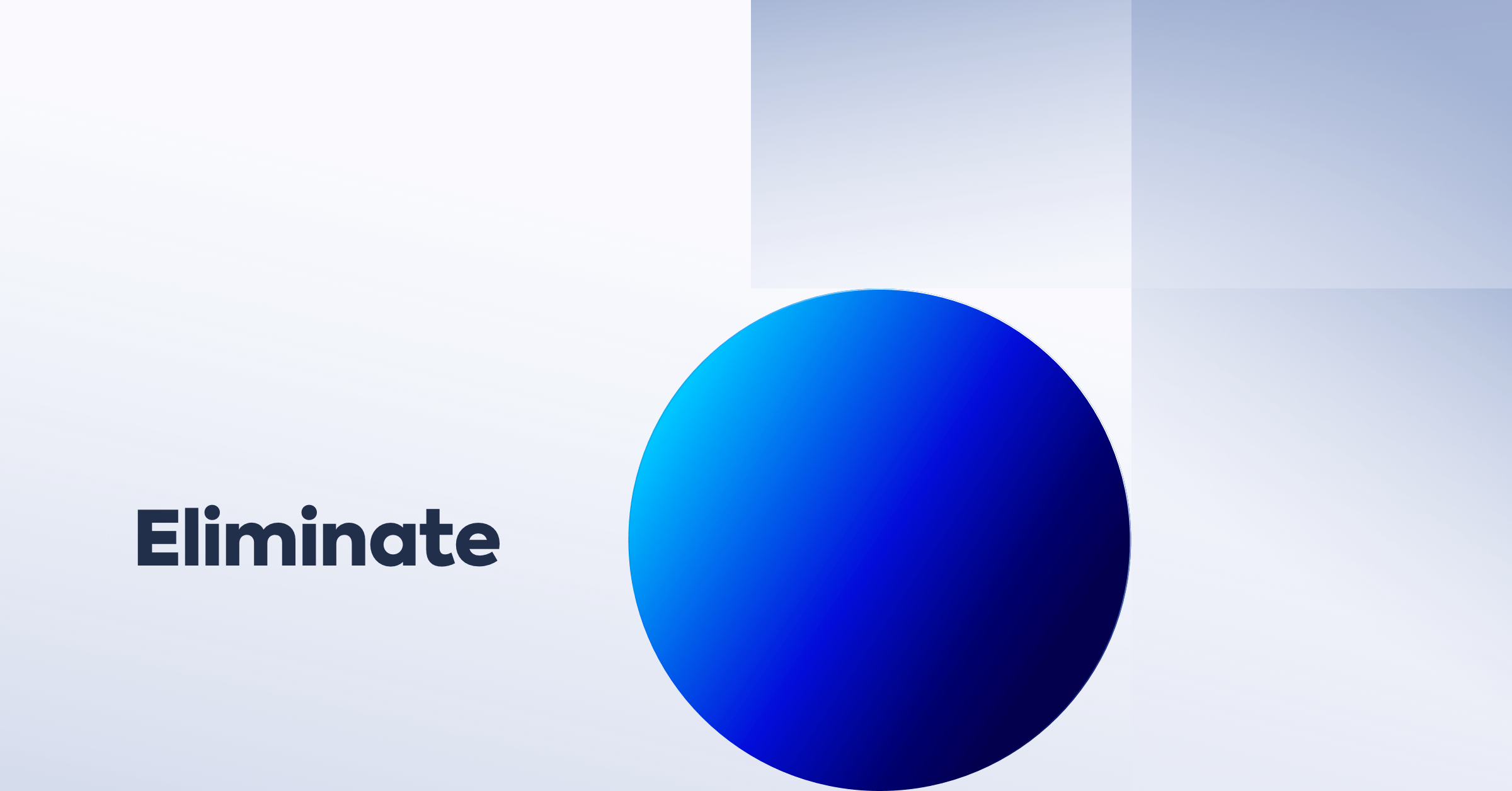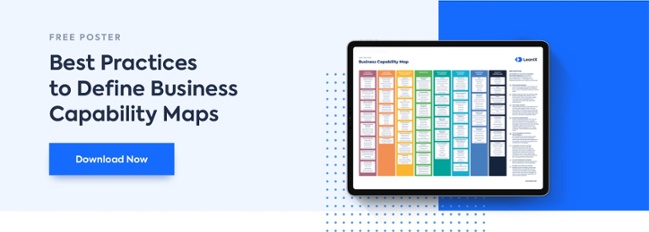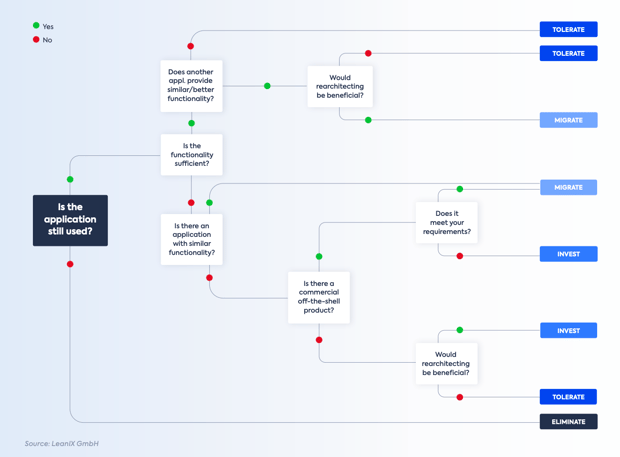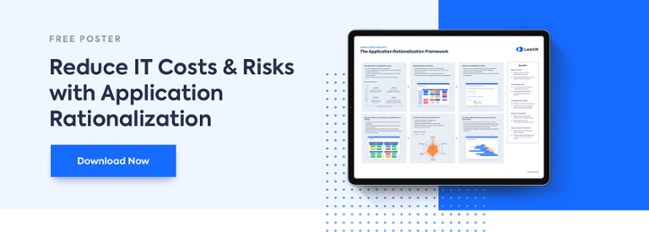
The Gartner® TIME framework for application rationalization offers you step-by-step instructions on how to make the difficult decision to sunset an application from your portfolio. We deep-dive into how this best-practice methodology supports your initiatives.
This series of articles has covered each of the four quadrants of the Gartner® TIME framework for application rationalization:
In the final part of the series, we consider the last category: Eliminate. This is, of course, what most enterprise architects are intending to do when they begin application rationalization, and is perhaps the only one of the four categories that is purely about cost reduction, rather than efficiency.
It is also the most challenging category. Removing the wrong application from your portfolio could send your tech stack plummeting down like a house of cards.
Before you undergo any application rationalization process, you should first gain a clear overview of your application portfolio. This is where the LeanIX enterprise architecture management (EAM) platform comes in.
LeanIX EAM For Application Rationalization
The LeanIX enterprise architecture management (EAM) platform empowers you to acquire complete data sets on your entire application portfolio with automation. You can then view these data sets in multiple formats with varying levels of data to make it accessible to everyone in your organization.
To learn about how the LeanIX EAM can support your application rationalization initiatives, see our application rationalization page:
USE CASE: Application Portfolio Assessment & Application Rationalization
In the meantime, the final part of our series of four articles looking at the Gartner® TIME framework will consider Eliminate more closely. First, however, let's recap the framework as a whole.
A Rapid Recap Of The Gartner® TIME framework
The Gartner® TIME framework has become standard practice for enterprise architects carrying out application rationalization initiatives. The framework maps each of your applications into one of four quadrants of a matrix.
The matrix is based upon the quality of your application (technical fit) - how it performs and fits into your architecture - and its value to your business (functional fit). Rating each application as high or low for these two items indicates which of the four statuses to apply to it.
Assessing your applications for technical fit involves considering:
- service levels
- risk
- maintainability
- reliance on technical experts
- information quality
- and so on
Functional fit, meanwhile, relates to how the application fits the business capabilities your organization needs. To help you map your necessary business capabilities to your applications, we've created a template business capability map that you can download for free:

Assign one of the two ranks to each of your applications for technical and function fit, and you'll then be able to assign a status to it, as follows:
- Applications with high technical fit, but low functional fit will be Tolerated
- Applications with high technical fit and high functional fit will be Invested in
- Applications with low technical fit and high functional fit will be Migrated
- Applications with low technical fit and low functional fit will be Eliminated
Each of these then offers a full strategy for dealing with them, as follows:
- Tolerate - accept the application in its current state for the time being
- Invest - prioritize in gaining maximum value from this application
- Migrate - work on finding a better application to fulfill this need
- Eliminate - remove the application as it is not needed or desirable
To put it another way, take a look at our flow chart from our Application Rationalization Playbook:

This article will focus on the final quadrant: Eliminate. When an application is performing poorly and is no longer aligned with activities your business needs to carry out, you should plan to remove it from your application portfolio.
Why The Acronym "TIME" Matters For Gartner's Framework
If it's a co-incidence that the Gartner application rationalization categories create the acronym "TIME", it's a lucky one. The unmentioned fifth consideration beyond Tolerate, Invest, Migrate, and Eliminate, is the future.
Once you've added each of your applications to the TIME matrix, you need to consider what will change going forwards. Repeat the process for next quarter, next year, and longer term.
Will your applications:
- lose support?
- require investment to update?
- cease to align to your business strategy?
- become more important for your goals?
- require more licenses?
- etc
Remapping your applications based on their likely status in the future will allow you to build a roadmap for dealing with your application portfolio going forward. It will also save effort with repeating application rationalization on a regular basis.
How You Treat Eliminate Applications Under The Gartner® TIME framework
If you've read our previous articles in this series, you will know that the four quadrants of the Gartner® TIME framework don't necessarily call for immediate action. The statuses merely indicate how the applications should be dealt with on your roadmap.
As such, the Eliminate status doesn't mean deleting the app from your systems today. It does, however, give you some guidelines for dealing with applications marked for elimination:
1. Zero Investment Into Eliminate Applications
The application has been deemed inadequate in technical terms, and is not necessary for your business needs. As such, there should be no investment or support offered for the application to preserve resource.
2. Mitigate Risk
Further, since the application has been seen to have a low technical fit, this could mean it has security vulnerabilities. Minimizing investment, you will still need to mitigate those risks until the application can be removed.
3. Gain Buy-In
It's important that you notify your users that the app will be removed and why. While there will likely be few users remaining for the application, there may still be some change management involved. We'll go into this later on in the article.
4. Work Through Dependencies
An application that doesn't align with your business capabilities should have little impact on your IT landscape. However, returning to our house of cards analogy, you still need to be careful, as legacy applications can support other, more-critical apps within your business.
The last two stages of the above guidelines are, perhaps, the most nuanced. Let's look through each in turn.
Gaining Stakeholder Buy-In To Eliminate Applications
As we said above, since Eliminate applications fall outside business capabilities, there shouldn't be a great deal of resistance to sunsetting the application, but it is possible.
In our experience, there are sometimes small groups of users who will object to the removal of a tool. This can be for a number of reasons and there's a different strategy for dealing with each:
1. Obsolescence
When a user has been working with a particular application throughout their career and then see that tool being retired, they can feel as if their function in the business is redundant. In this case, it's vital to showcase the applications that are still available to them in their work.
2. Skillsets
Similarly, users can feel that the loss of an application they are skilled in using may reduce their value to the business. Offer them additional training in other applications that are more aligned with business needs.
3. Resistance
Lastly, it's simple human nature to resist change and some will hold onto old applications out of habit. Here, use your application research to showcase the limitations of the Eliminate application and why the decision has been made. The LeanIX enterprise architecture management (EAM) platform can support you with visualizing this data.
Working Through Dependencies When Eliminating Applications
As we mentioned, Eliminate applications will not be aligned with your business capabilities. However, this doesn't mean that they don't support applications that do.
For example, a cutting-edge artificial intelligence (AI) application could have been built on data from an old Lotus 1-2-3 spreadsheet. On the other hand, perhaps your old employee intranet portal has been replaced by Office 365, but still holds important process playbooks.
Determining the dependencies of Eliminate applications and gradually removing them like cutting wires on a time bomb can be a tremendous effort. Confirming all dependencies and mapping out a strategy for removing them is crucial.
That's where the LeanIX enterprise architecture management (EAM) platform can support you. By automating information-gathering and user surveys, the effort of information gathering is dramatically reduced.
To find out more, book a demo:

Eliminate For Cutting Costs Under Gartner® TIME Framework
Eliminate is the least-positive status under the Gartner® TIME framework, and can often require a great deal of effort. However, this status remains crucial to your application rationalization initiatives as this is the source of the cost-savings that enable re-investment.
Diverting wasted resource from unnecessary applications in order to invest it into applications that produce value is the heart of efficiency. Organizations that can do so and repeat that process over and over will remain agile and thrive.
That's why application rationalization is so important, and it starts with the LeanIX enterprise architecture management (EAM) platform. Find out more about how the LeanIX platform supports your application rationalization efforts in the Gartner® TIME framework:



